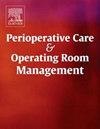Red cell distribution width as a predictor for post-operative atrial fibrillation after open heart surgeries
IF 1
Q2 Nursing
Perioperative Care and Operating Room Management
Pub Date : 2025-08-06
DOI:10.1016/j.pcorm.2025.100539
引用次数: 0
Abstract
Background
Post operative Atrial Fibrillation _POAF_ is the most common type of arrhythmia after open heart surgeries with incidence 30–50 %. Atrial fibrillation has been a challenging postoperative morbidity, its mechanism is yet to be known, however, a lot of studies have tried to find a predictive biomarker for POAF, in this study we investigated the relationship between Red cell distribution width (RDW)_ and the prediction of POAF
Methodology
the eligible patients were 76 patients, the duration of study was 2 months of data collection, Patients enrolled in the study was allocated into two groups according to development of POAF. Group A: patients develop POAF. Group B: patients didn’t develop POAF. Pre operative RDW was compared between the two groups, ROC analysis is done for all patients to predict POAF.
Results
there were significant statistical difference between groups preoperative and post operative RDW (p-value 0.023, 0.011, respectively), ROC analysis for RDW in all patient to detect POAF sowed AUC 0.634 with cut off value >15.1 with sensitivity 58.62 % and specificity 78.72 %.
Conclusion
We found that RDW was significantly higher in patients who developed POAF in comparison to patients who didn’t develop atrial fibrillation.
红细胞分布宽度作为心脏直视手术后房颤的预测因子
背景:术后心房颤动(poaf_)是心脏直视手术后最常见的心律失常类型,发生率为30 - 50%。心房纤颤是一种具有挑战性的术后发病率,其发病机制尚不清楚,然而,许多研究都试图寻找一种预测POAF的生物标志物,在本研究中,我们研究了红细胞分布宽度(RDW)_与POAF预测的关系。A组:发生POAF的患者。B组:未发生POAF。比较两组术前RDW,对所有患者进行ROC分析预测POAF。结果两组患者术前、术后RDW差异有统计学意义(p值分别为0.023、0.011),ROC分析所有患者RDW检测POAF的AUC为0.634,截断值为15.1,敏感性58.62%,特异性78.72%。结论:我们发现发生POAF的患者的RDW明显高于未发生房颤的患者。
本文章由计算机程序翻译,如有差异,请以英文原文为准。
求助全文
约1分钟内获得全文
求助全文
来源期刊

Perioperative Care and Operating Room Management
Nursing-Medical and Surgical Nursing
CiteScore
1.30
自引率
0.00%
发文量
52
审稿时长
56 days
期刊介绍:
The objective of this new online journal is to serve as a multidisciplinary, peer-reviewed source of information related to the administrative, economic, operational, safety, and quality aspects of the ambulatory and in-patient operating room and interventional procedural processes. The journal will provide high-quality information and research findings on operational and system-based approaches to ensure safe, coordinated, and high-value periprocedural care. With the current focus on value in health care it is essential that there is a venue for researchers to publish articles on quality improvement process initiatives, process flow modeling, information management, efficient design, cost improvement, use of novel technologies, and management.
 求助内容:
求助内容: 应助结果提醒方式:
应助结果提醒方式:


